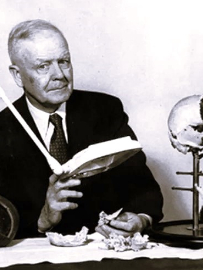The foundations of therapy were laid with the work of Dr. William G. Sutherland (1873-1954), the creator of Cranial Osteopathy and a student of Dr. Andrew Taylor Still (1828-1917), the founder of Osteopathy.
Sutherland learned that the bones of the adult skull fused, losing mobility. However, observing the way these structures were assembled made him think that they were designed to have the possibility of movement.
He conducted a series of experiments on his own skull to prevent or change these potential movements; and was able to demonstrate various physical, emotional and cognitive disorders in his body. He concluded that the cranial sutures and associated bones must retain movement for the body to function properly.
He began with a biomechanical approach, applying gentle external forces to the skull to correct imbalances present in the body. Over time, moving away from the physical manipulation approach, he transitioned to a model focused on the body’s innate ability to balance itself. Thus, encouraging the client's system to find the tools for its healing process.
The Osteopaths Drs. Rollin Becker (1919-1996) and James S. Jealous (1943-) further developed and expanded Sutherland's findings, including embryonic and nonverbal stages imprint. It was the English osteopath Dr. Franklyn Sills (1947-); who continued to investigate and deepen its scope, establishing the name Craniosacral Biodynamic Therapy in the early '90s.
“I try to restore health. I'm not trying to correct the problem. In this way, I open the doors for the body to do what it needs to do with its own life force.” Dr. Rollin E. Becker

